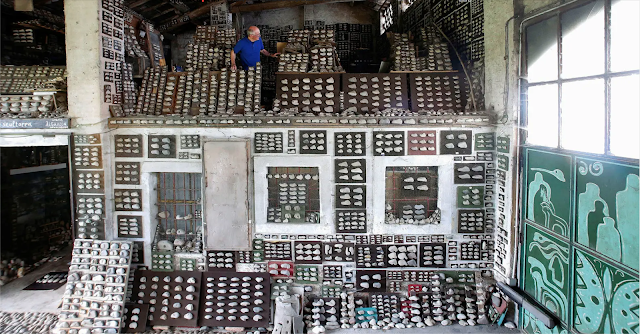I like when she said, “The souvenir must remain impoverished and partial so that it can be supplemented by a narrative discourse, a narrative discourse which articulate the play of desire”. I think that found objects particularly old or looking poor do help us feel the sense of nostalgia really well and human history in the objects. It become curious for us to navigate even without knowing, the experience of the original possessor. I have come to realize that when we pick an object, one thing that reminds us of ourselves is our role to immortalize that experience although in new context yet emanating from a trajectory of the original function. Susan said, the collector can gain control over repetition or series by defining a finite set or by possessing the unique object.
She adds, "the collector can gain control over repetition or series by defining a finite set". The collector expresses obsession and value with repetition, some as a means of exaggeration, In the case of an artist, he displays the work also in a form fantasy and the critical way to seduce the audience. “ the boundary between collection an fetishism is mediated by classification and display in tension with accumulation and secrecy" With this analogy, I intend to relate it to Romuald Hazoume's work. He collects use gallons from different places and transform them to become a new object. He plays with repetition in his work, articulating his narrative as he investigates how the Europeans have taken most of the African masks and denied African's access to their history. In that sense he intends to recreate his new form of African mask with used gallons. He also plays with fetishism in his work, he decorates the masks with hair and cloths to express beauty in his masks.
I like where she said, “ learn what you can about each object before you put it in the museum, and docket it not only with its name, but also with the name of the place in which you found it, and the date. I think that when we pick an object, their mundane settings help us with the concept in terms of its transformation, the curiosity of its experiential quality is when the viewers imagine where and what of the objects and how they have been transposed to have a new context in the exhibition space.
Le Bouget, 2016
I see that the collection explores the identity of the possessor and his identity and it also relates to the relationship between the collected objects and the possessor. That is where the narrative emerges, the possessor then articulates the past experience in terms of how that relates to the objects that he has collected. “In order to construct a narrative of interiority it is necessary to obliterate the object’s context of origin” (pg 158). The exchange of value it hereby related to this context. Sometimes there is a sort of infinity, there is a secret within the objects that their details may not be fully revealed to us.She adds, "the collector can gain control over repetition or series by defining a finite set". The collector expresses obsession and value with repetition, some as a means of exaggeration, In the case of an artist, he displays the work also in a form fantasy and the critical way to seduce the audience. “ the boundary between collection an fetishism is mediated by classification and display in tension with accumulation and secrecy" With this analogy, I intend to relate it to Romuald Hazoume's work. He collects use gallons from different places and transform them to become a new object. He plays with repetition in his work, articulating his narrative as he investigates how the Europeans have taken most of the African masks and denied African's access to their history. In that sense he intends to recreate his new form of African mask with used gallons. He also plays with fetishism in his work, he decorates the masks with hair and cloths to express beauty in his masks.



















